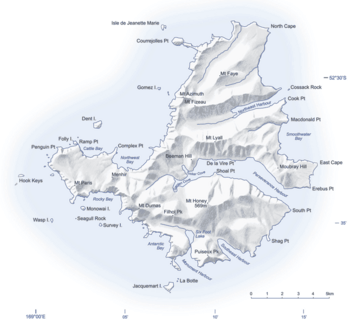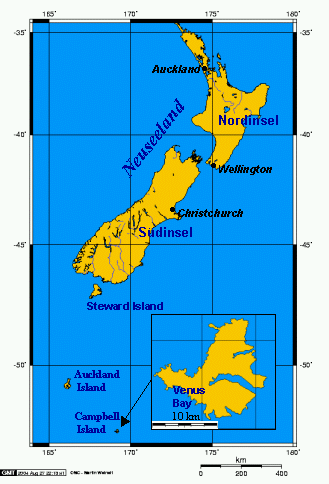Campbell Islands facts for kids
The Campbell Islands are a group of small islands that belong to New Zealand. They are located very far south, about 600 kilometers (370 miles) from Stewart Island. These islands are part of the subantarctic region, which means they are just north of the Antarctic Circle.
The total area of the Campbell Islands is about 113 square kilometers (44 square miles). Most of this area is taken up by one main island, also called Campbell Island. There are also several smaller islands and islets. These include Dent Island, Isle de Jeanette Marie, Folly Island, Jacquemart Island, and Monowai Island (also known as Lion Rock).
The Campbell Islands are a very special place for nature. They are part of a larger group of subantarctic island groups that are recognized as a World Heritage Site by UNESCO. This means they are protected because of their unique natural importance.
Contents
Exploring the Campbell Islands' Geography
The Campbell Islands might seem flat at first glance. However, due to natural forces deep within the Earth, there are mountains in the middle of each island. The highest point is Mount Honey, which is 558 meters (1,831 feet) tall.
One interesting fact is that a tall rock formation, called a sea stack, at the southern tip of Jacquemart Island is the southernmost point of New Zealand. This does not include New Zealand's claims in Antarctica.
Wildlife and Nature on the Islands
The Campbell Islands are home to many unique plants and animals. However, for a long time, their nature was in danger. When people first discovered the islands in 1810, they brought new animals with them. These animals were not native to the islands.
Challenges for Wildlife
Animals like cats and Norway rats hunted the native birds. Large animals like sheep and cattle ate a lot of the plants. This caused big problems for the island's natural environment. Many native species struggled to survive.
Bringing Nature Back
Starting in 1970, people began working to help the islands recover. First, they removed the wild cattle and sheep. After these animals were gone, the plants on the island started to grow back thicker and healthier.
In 2001, a big effort was made to remove the rats. Four helicopters helped spread special bait across the island. This operation lasted for one month. Since then, no signs of rats have been found. This successful project has even helped other islands around the world learn how to remove harmful animals.
Important Bird Area
The Campbell Islands are known as an Important Bird Area (IBA). This is a special title given by BirdLife International. It means the islands are very important for birds, especially for breeding.
Many types of seabirds come here to lay their eggs and raise their young. These include different kinds of rockhopper and yellow-eyed penguins. You can also find several types of albatrosses, like the Antipodean, southern royal, light-mantled, black-browed, Campbell, and grey-headed albatross. Other seabirds include northern giant and white-chinned petrels, and the Campbell shag.
The islands are also home to two special birds that live only there: the Campbell teal and the Campbell snipe.
See also
 In Spanish: Islas Campbell para niños
In Spanish: Islas Campbell para niños



